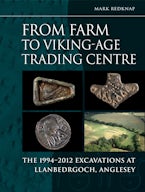The discovery of early medieval artefacts by metal detectorists at Glyn, Llanbedrgoch, Anglesey from the late 1980s led to a long-term programme of archaeological investigations by the National Museum of Wales (now Amgueddfa Cymru). Excavation revealed rich evidence for human activity from the Mesolithic period to the present, but its international recognition as a transformative site has been based on the remarkable early medieval evidence covering the 5th- to 6th-century transition up to the 11th century.
The early medieval enclosed settlement has produced the richest archaeological record in pre-Norman Wales for this period of political and cultural transformation. The site provides a unique sequence of development from small farm and entrepôt to a developing regional centre from the 7th century. By the 10th century, Llanbedrgoch had become an important commercial centre for the kingdom of Gwynedd, while possibly functioning in the manner of an estate centre with proto-urban potential. The excavated evidence shows an influx of material culture that is mixed, vibrant and in tune with the data from other sites around the Irish Sea and the Continent.
This publication integrates all the archaeological evidence discovered, including the first house plans from Viking-age Wales and details of objects made, cherished, consumed, destroyed and repaired. Eight early medieval burials provide data on personal appearance, health, diet and origins (including slavery), and four have facial reconstructions. New artefacts classifications and interpretations are provided, and corpora on dress accessories, hacksilver, household equipment and quernstones found in early medieval Wales presented. The social, economic and political contexts are discussed.
Acknowledgements
Summaries (Welsh, French, German)
Section 1. Introduction and Setting
1. The Site and its Setting
2. Discovery of the Sites
Section 2. The Excavations
3. Survey and the Excavation Strategy (1994–2001, 2004, 2012)
4. The Sites and their Excavated Features
5. Dating and Chronology
6. Structural Timber
Section 3. Archaeozoology and Environments
7. Palaeo-environmental Evidence
8. Archaeozoological Evidence: The Faunal Assemblages
Section 4. The Human Remains
9. The Human Remains and their Analyses
10. The Human Remains: Wider Contexts and Meanings
Section 5. Prehistoric and Roman Artefacts
11. The Prehistoric Artefacts
12. The Roman Artefacts
13. The Roman Coins, by Edward Besly
Section 6. Early Medieval Artefacts
14. Items of Commerce and Exchange
15. Items of Dress and Personal Appearance
16. Personal Possessions, Toiletry and Hygiene
17. Items of Hospitality and Leisure
18. Household/Personal Equipment
19. Food Preparation
20. Weapons and Horse Equipment
21. Structural Fittings and Related Items
22. Miscellaneous Objects of Uncertain Function
Section 7. Evidence for Craft Activities
23. Tools and Implements
24. Early Medieval Metalworking Crafts
25. Early Medieval Textile Production
26. Bone, Antler and Leatherworking
Section 8. Post-Settlement Finds (Medieval and Later) From Glyn, Llanbedrgoch
27. Medieval Finds
28. Post-medieval Artefacts
28. Objects of Uncertain Date
Section 9. Llanbedrgoch in Context
29. Prehistoric and Roman Anglesey by Andrew Davidson and GAT
30. Early Medieval Kingdoms and Historical Contexts
31. Primary Sources
32. The Significance of Llanbedrgoch
Appendix 1. Context Summary
Appendix 2. Key Stratigraphic Matrices
Appendix 3. Glossary of terminology
Appendix 4. Inventory of the Human Bone
Appendix 5. XRF of metalwork
Appendix 6. Petrographic analysis of prehistoric pottery, by Dr John Ll. W. Williams and Dr David Jenkins
Bibliography
Index












